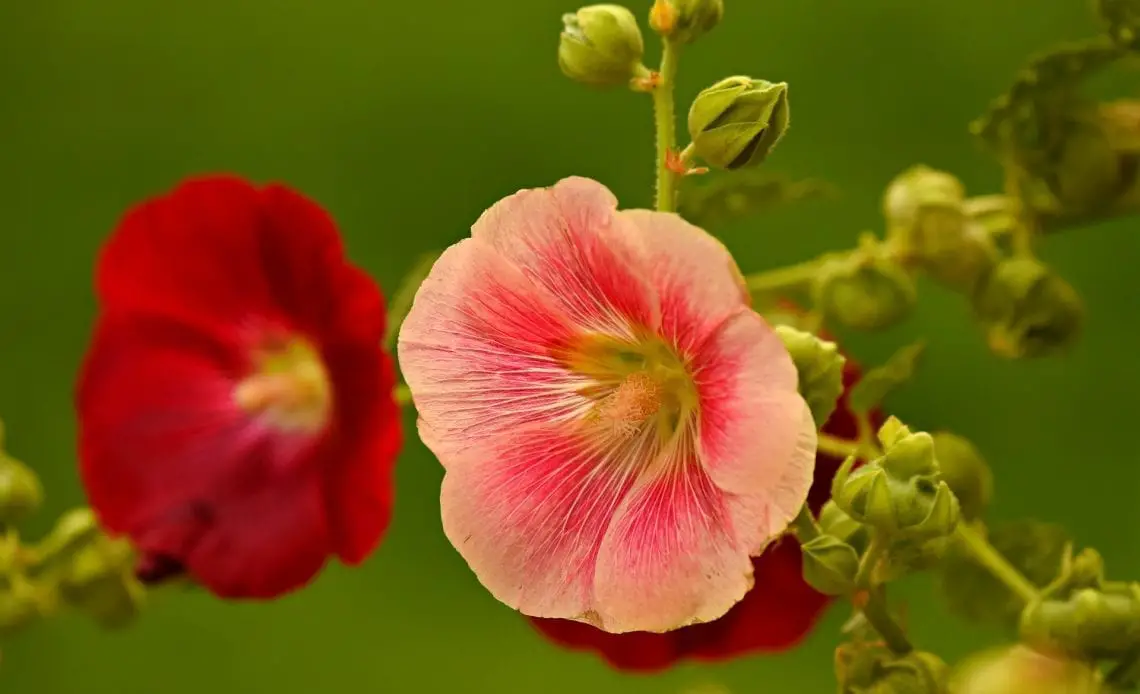
Last updated on May 21st, 2023 at 09:12 am
The hollyhock flower (Alcea rosea) is a genus of approximately 60 species in the family Malvaceae. Hollyhocks are hardy biennials (take two years to bloom) and short-lived perennials. The blow-shaped flowers are from 7 to 15 cm wide, depending on the variety. They can be white, pink, yellow, red, purple, apricot, or black.
The hollyhock plant owes its unique appeal to the arrangement of multiple flowers along a tall standing stalk. The stalk resembles a staff completely covered in flowers from every side. The flowers blossom progressively from the bottom to the top of the stalk. It has been reported that some hollyhock plants have grown seven meters tall.
In Ancient China, hollyhocks were popular plants in the flower gardens of wealthy patrons. The flowers were then spread from the Orient to the Middle East (Syria) through trade pathways. The Crusaders, returning to Western Europe, carried with them seeds of this flower and propagate the species on the European continent.
The Latin name of the hollyhock plant, Alcea, is derived from the Greek word for healing, ‘altho.’ The common name hollyhock is a coined word created from two root words—‘holy’ and ‘hock.’ ‘Holy’ is a reference to both the healing powers of the plant and the belief that it was brought to England from the Holy Land. ‘Hock’ is an Old English word that means mallow.
What does the Hollyhock flower symbolize?
Hollyhocks symbolize the circle of life and the passage of time. This flower symbolism is derived from an important archeological finding. Between 1957 and 1961, in the Shanidar Cave, an excavation site within the Zagros Mountains in northern Iraq, archeologists unearthed nine skeletons of Neanderthals. The scientists estimated that those remains dated from approximately 65,000 to 35,000 years ago.
They also found evidence that our closest extinct human ancestors performed burial rituals. Clumps of hollyhock pollen were found in the cave. Based on this, the archeologists hypothesized that the Neanderthal Shamans used hollyhock because of their medicinal properties.
The Ancient Egyptians also buried their mummified dead with wreaths made of hollyhock flowers. Traces of hollyhock flowers have been found in the coffin of the ancient Egyptian pharaoh Tutankhamun.
Hollyhocks, also known as St. Joseph’s staff, were used as a popular motif to represent the saint in various South European paintings. The Spanish version of this name was ‘Las Varas de San Jose.’ The symbolic association came from the flower’s adaptability and resilience to a wide variety of soil and climate. The hollyhock flower thus became a symbol of God’s mercy.
Two older botanical names, Malva Benedicta and Caulis Santi were once given to the plant. These names indicate that the hollyhock flower is often associated with holy men and saints.
Every year on August 29, yellow hollyhock flowers are used as church decorations. This is the day when St. John the Baptist’s death is commemorated.
Tokugawa Ieyasu, the first shogun of the Tokugawa shogunate of Japan and one of the three ‘Great Unifiers’ of Japan, used the hollyhock as a floral motif in his family crest. The motif was painted on kimonos, lacquerware, and other objects. It was a symbol of nobility, high status, and honor.
One of the common names of the hollyhock flower is althaea. Althea in Ancient Greek means ‘healer.’ In Greek Mythology, Althea was a beautiful goddess of healing and compassion, family, marriage, and protection. She was the daughter of King Thestius and Eurythemis.
All in all, the hollyhock flower symbolic meanings are:
- fertility
- fruitfulness
- ambition
- love
- friendship
- happiness
- abundance in life
Meaning of the Hollyhock flower colors
Red color
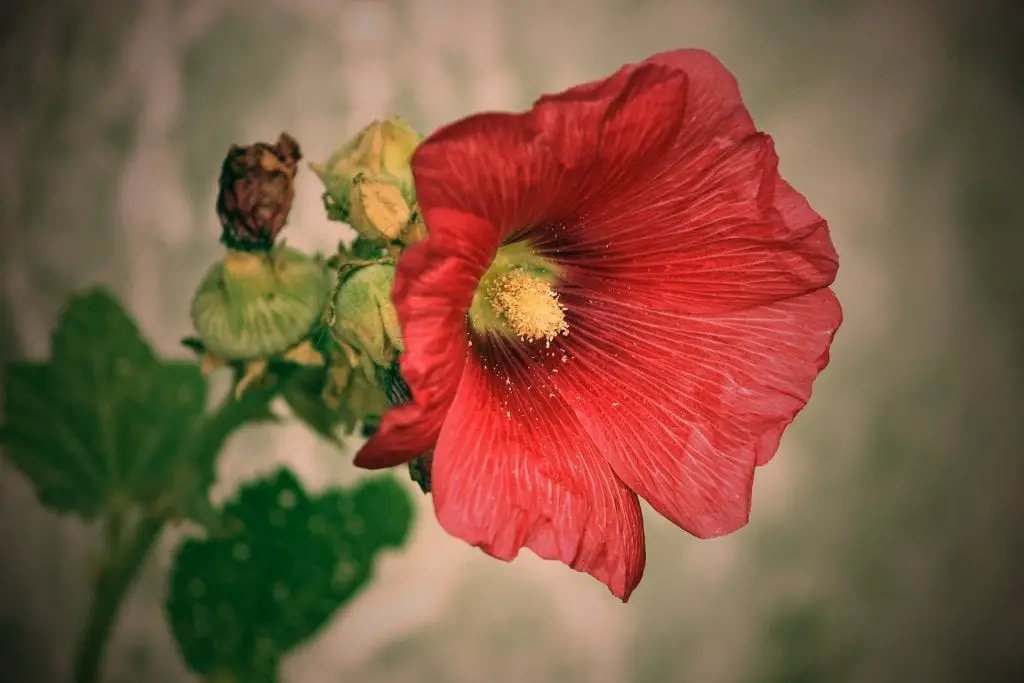
The red hollyhock flower symbolizes a woman’s motherly love for her children and passionate love for her partner. This symbolism is derived from the goddess Althea (the Latin name of the hollyhock flower). The goddess did everything in her power to protect her son Meleager whom the Moirai (the Fates) predicted an early death.
White color
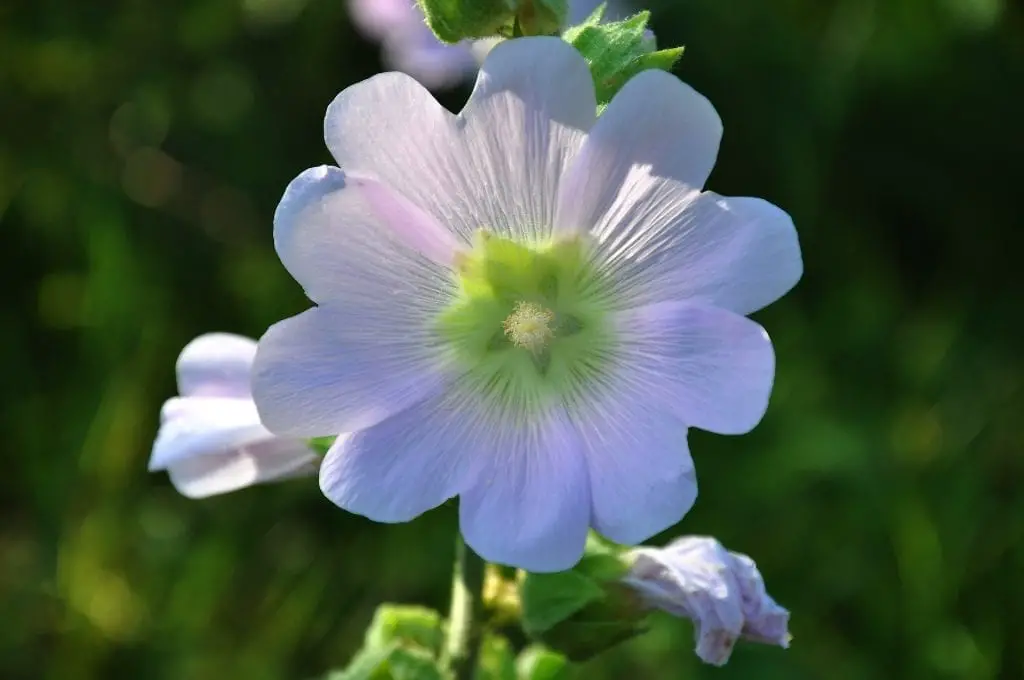
The white hollyhock flower symbolizes a woman’s innocence and purity. They also stand for ambitions fulfilled through rightful and benevolent means.
Yellow color
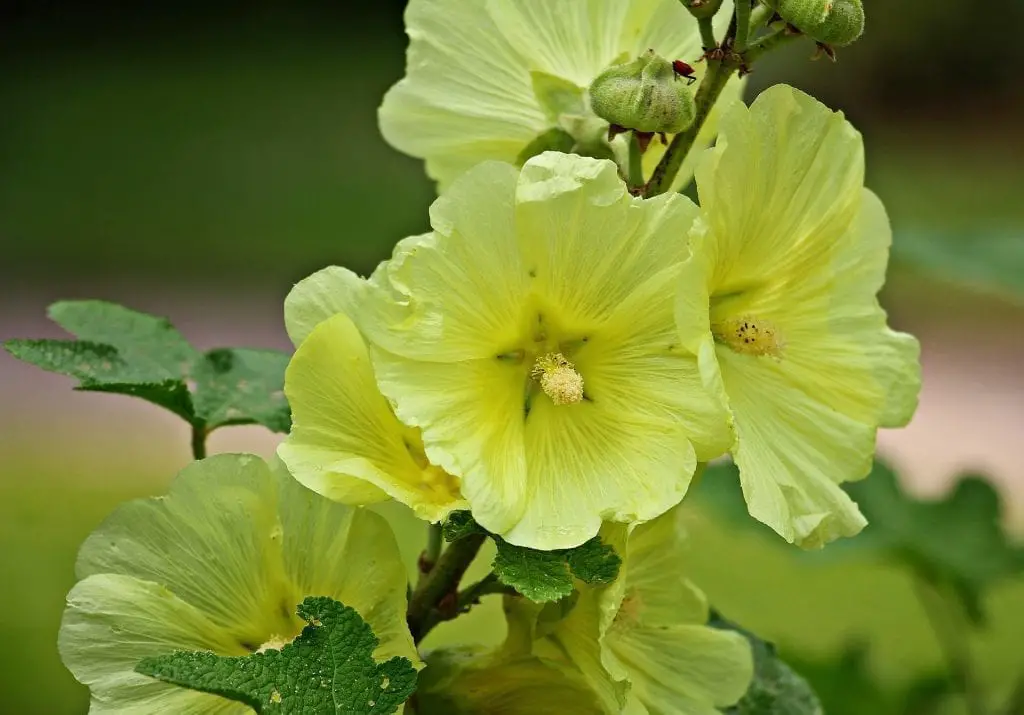
The yellow hollyhock is a flower of recovery and regeneration. It signifies the ability to heal and re-balance after a challenge or a difficult period. The yellow bloom also stands for happiness, friendship, and platonic love.
Purple color
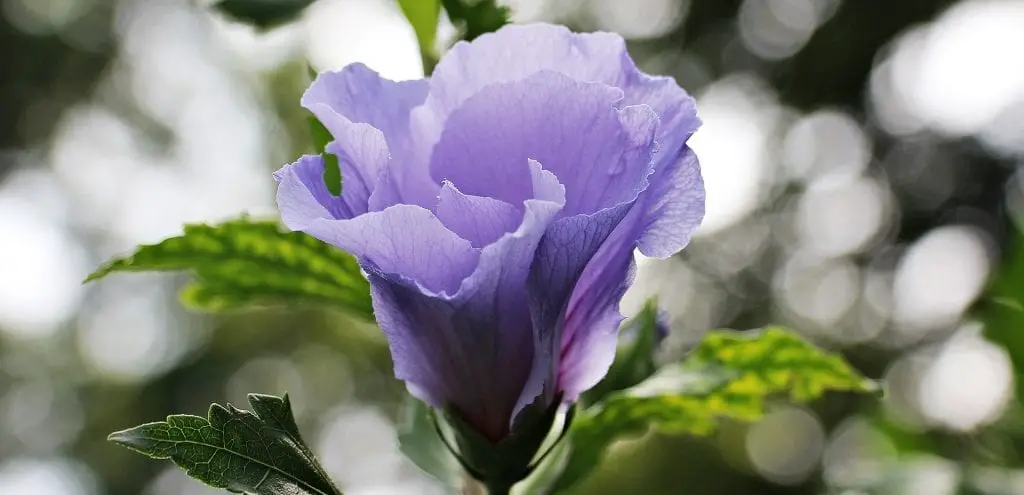
The purple hollyhock embodies aspects of spirituality, nobility, and integrity.
Pink color
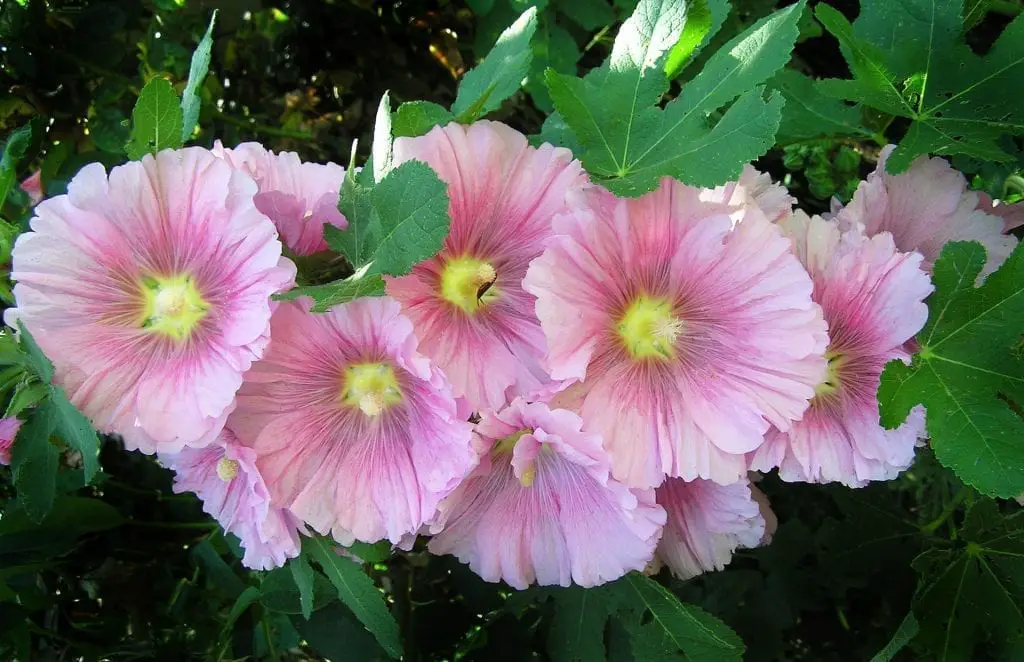
The pink hollyhock is a flower of femininity. It represents both the female gender and the inner feminine part of the soul. Beauty, strength, sympathy, and receptivity are some of the many attributes of the pink hollyhock flower.
Black color
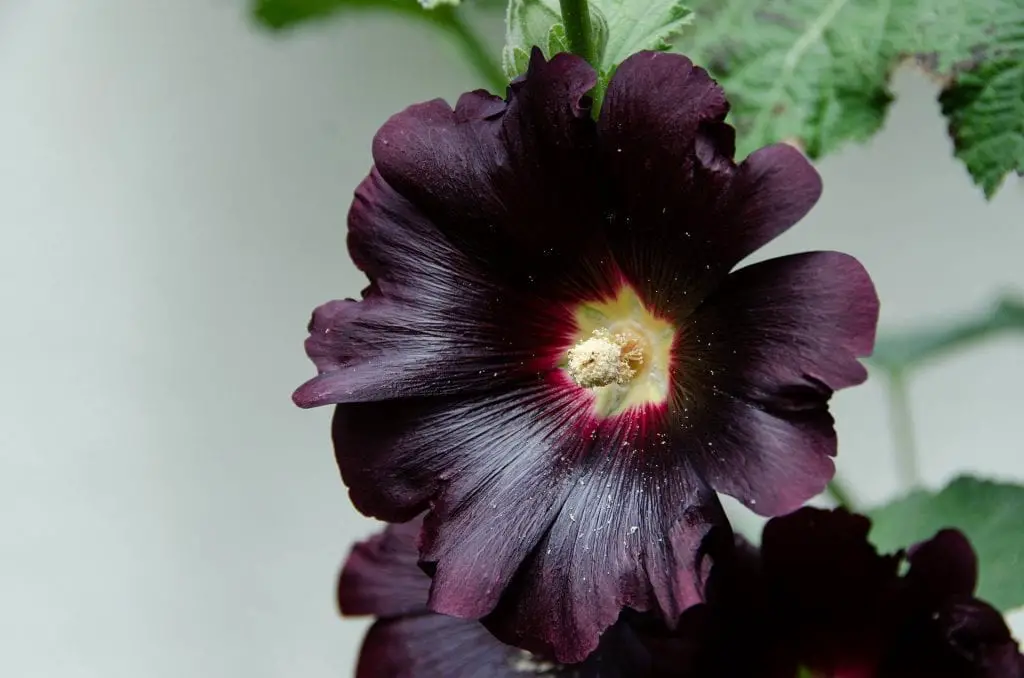
The black hollyhock is associated with fruitful ambitions, achievements, and abundance.
Interesting facts about the Hollyhock flowers
- Between the 13th and the 16th century, many botanists, philosophers, and physicians, including Albertus Magnus and William Turner, wrote about the medicinal properties of the hollyhock. The flower, also called the ‘holy mallow,’ was used as a diuretic, laxative, emollient, and anti-inflammatory treatment.
- Aoi Matsuri, an annual festival held on May 15 in Kyoto, Japan, is dedicated to the hollyhock flower. Historical records show that the festival has been celebrated at two ancient shrines from the seventh century. The spiritual significance of the festival is twofold. It is believed that during the festival, people undergo spiritual purification, removing their sins. Priests also make offerings to the gods and, in return, receive their blessings.
- The hollyhock is the unofficial city flower of Taos, New Mexico. This goes back to an early settler, Teresina Bent Scheurich, who was the daughter of New Mexico’s first governor. Miss Teresina actively promoted the cultivation of hollyhocks in the city of Taos.
- Today hollyhocks are considered an invasive species due to their hasty proliferation.
- Hollyhocks are edible, but the taste of their flower is rather bland. Hollyhocks are added to stews and soups, buds are used in salads, and young leaves can be either raw or cooked. Hollyhock petals are often used to garnish fish.
- The leaves of the hollyhock are slightly hairy.
- The schizocarp fruit of the hollyhock plant contains 15–20 small seeds.
- The tallest hollyhock in recent times was documented in the 2021 Guinness Book of Records. According to this source, it was grown by Meir Baruchi (Israel) in Nahariya, Israel,, which was 24 ft 2 in (7.4 m) tall.
- Alcea rosea nigra, also known as Jet Black or Nigra hollyhock, was once planted by Thomas Jefferson at Monticello.
- The color of the black variety hollyhock flower (Alcea rosea nigra) is violet-brown.
- The black hollyhock was first described in 1629.
- In 19th-century Germany, the black-flowered hollyhock was used to color wine.
- Hollyhocks were once used as a traditional medicine to prevent miscarriages. The potion was made by soaking hollyhock flowers in wine.
- In Tibet, the roots and flowers of hollyhock are used to treat inflammation of the reproductive and urinary systems.
- There are many confirmed health benefits of the hollyhock plant. Most notably, hollyhock improves blood circulation, prevents kidney disease, reduces high fever, and can ease difficult labor pains. The root of the plant regulates digestion and increases the metabolism rate.
- The flowers of Alcea rosea nigra have been used to produce a dye of many color hues, from pale lavender to dark purple.
- The Crusaders treated their horses with a salve made from the hollyhock plant. This medicine healed the wounds on the animal’s hind legs, or “hocks.” According to some historiography, the word hollyhock is derived from the words ‘holy’ (the Holy Land) and hock (the horse’s leg).
- One of the most popular hollyhock varieties of all time was developed in the 1880s by Chater of Essex, an English horticulturist. The name of this hollyhock flower was Chater’s Double.
- After an outbreak of a rust disease that attacked hollyhock flowers in 1873, the cultivation of these flowers was completely abandoned. They made a comeback in the 1930s.
- The family of hollyhocks also includes okra, cotton, and hibiscus.
How to grow Hollyhock flowers
Hollyhocks easily grow and produce blooms in various catchy colors from early summer through autumn. Their tall spikes look nice against walls and fences and are popular in cottage gardens.
- Plant the hollyhocks in fertile, well-drained soil.
- Place them where they can get full sun.
- Add a layer of well-rotted garden compost to the soil.
- Maintain the soil damp but not soggy in the first few months.
How to care for Hollyhock flowers
- Only water the hollyhocks in prolonged dry or hot spells.
- No need to apply additional feeding.
- Cut the flower spikes to the bottom when the flowers have faded.
- Remove all dead leaves and dump those that have been poorly infected by rust disease.
Best time to gift Hollyhock flowers
Since all their known symbolism is positive, hollyhock flowers can be gifted on various occasions. These flowers are perfect for birthdays and anniversaries since they celebrate life. As a symbol of fertility and motherly love, these flowers can be gifted to couples to congratulate the baby’s birth.
Purple hollyhocks are the right way to express respect and admiration toward a mentor, teacher, or spiritual guide. All hollyhocks, especially the black ones, symbolize multitude, abundance, and prosperity. This makes them a perfect housewarming gift. Gifting white and pink hollyhock flowers is a wonderful way to recognize the ambitions and achievements of young women—from graduation to admission to a college to landing a job.
The height and sturdiness of the hollyhock stem symbolize stability, safety, and reliability. Gifting a hollyhock to parents can be a way to express appreciation and gratitude for their love and care throughout the years.
Gifting a hollyhock plant is a beautiful way of conveying wishes for everlasting happiness, abundance, health, and good luck to friends and family members who love gardening.
Conclusion
Hollyhock flowers represent the circle of life, ambition, fertility, and abundance. These flowers have traditionally been put by the front door to welcome prosperity into the home.
Hollyhock flowers present cottage or kitchen gardens and can be especially appealing when passed down through generations. These blooms will naturalize in the flower bed because they self-seed easily, bringing color to the bed for years to come.
If you want to know and learn more about flowers, we at PansyMaiden can help you. Check out our fun, easy-to-read, and informative flower-related content that you will surely enjoy!
